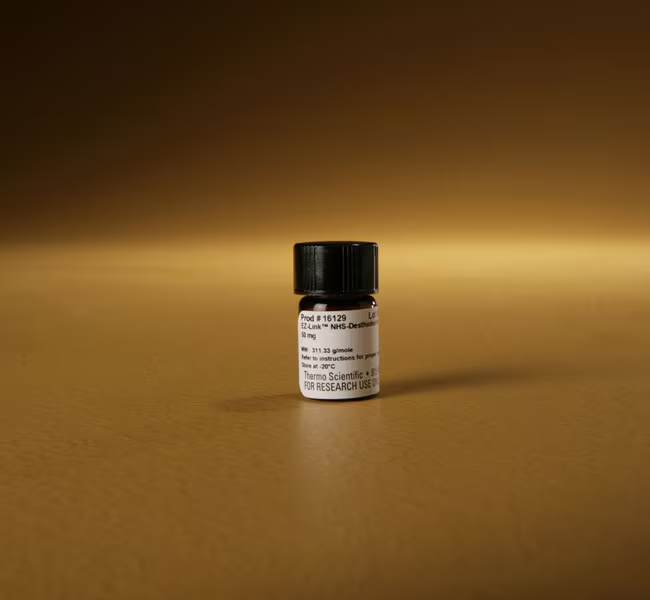
Thermo Scientific EZ-Link NHS-Desthiobiotin is a short, membrane permeable, amine-reactive labeling reagent whose biotin-like group is elutable from streptavidin, making it ideal for intracellular protein labeling and purification.
Features of EZ-Link NHS-Desthiobiotin:
• Desthiobiotin – analog of biotin allows easy elution from streptavidin, an ideal feature for affinity purification applications
• Protein labeling – tag antibodies or proteins in purified or mixed samples to enable high recovery in pull-down assays with streptavidin beads
• Membrane-permeable – achieve intracellular labeling with intact cells because the small, uncharged reagent easily diffuses across cell membranes
• Amine-reactive – reacts with primary amines (-NH2), such as the side-chain of lysines (K) or the amino-termini of polypeptides
NHS-Desthiobiotin is a variant of biotin that is activated as an NHS ester to covalently label primary amines (-NH2) of proteins or other molecules with desthiobiotin groups. The desthiobiotin tag binds to streptavidin and other biotin-binding proteins with high specificity yet readily elutes with mild conditions (i.e., by competitive displacement with regular, free biotin). As such, this reagent is a useful alternative to NHS-Biotin (Part No. 20217) for avidin-biotin techniques in which nondenaturing elution of the labeled proteins is desired. This simplest and smallest variety of amine-reactive desthiobiotin reagent is uncharged and cell membrane permeable; therefore, NHS-Desthiobiotin can be used with intact cells for intracellular protein labeling.
Desthiobiotin vs. Biotin
Desthiobiotin is a single-ring, sulfur-free analog of biotin that binds to streptavidin with nearly equal specificity but less affinity than biotin (1/Kd = 10^11 vs. 10^15M, respectively)[1-2]. Consequently, desthiobiotinylated bait proteins and their interacting partners can be eluted readily and specifically from streptavidin affinity resin using mild conditions based on competitive displacement with free biotin. For pull-down assay experiments with biological samples, this soft-release characteristic of desthiobiotin also helps to minimize co-purification of endogenous biotinylated molecules, which remain bound to streptavidin upon elution of the target protein complexes with free biotin. The modified avidin-biotin affinity system also eliminates the need to use harsh elution conditions that might disassociate complexes and/or damage the target protein or cell. Desthiobiotin-based techniques are ideal when using native or recombinant proteins that are not expressed with a fusion tag and when isolating captured proteins under native conditions, such as targeting intact cells or cell surface proteins.
Labeling with NHS Ester Reagents
N-Hydroxysulfosuccinimide (NHS) esters of biotin are the most popular type of biotinylation reagent. NHS-activated biotins react efficiently with primary amino groups (-NH2) in alkaline buffers to form stable amide bonds. Proteins typically have several primary amines that are available as targets for labeling, including the side chain of lysine (K) residues and the N-terminus of each polypeptide. Most sulfo-NHS esters are directly water soluble but not membrane permeable. Plain NHS esters are less soluble in aqueous buffers but are membrane permeable.
| Code | Description |
|---|---|
| 16129 | Catalog Number: 16129 |

